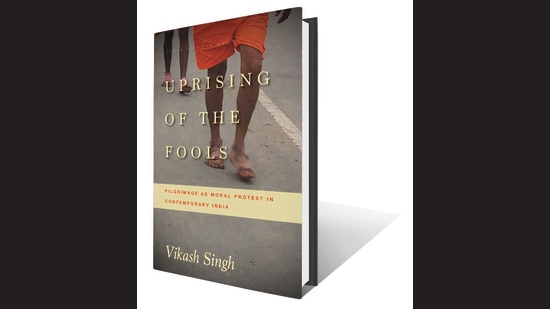Review: Uprising of the Fools by Vikash Singh
As they have swelled in numbers so have their woes. From few thousands half a century ago to an estimated 12 million now, these barefoot pilgrims continue to be ridiculed, almost reviled by the urban middle class for clogging roads and disrupting traffic. For those who don’t participate, this annual ritual of carrying holy water as an offering to Shiva is seen as an act of vulgate religiosity. Undeterred, the pilgrimage has a growing following among poor and lower-middle-class youth who have made kanwar one of the largest annual religious congregations in the country. What keeps them going, and what motivates others to join the ritual remains open to multiple interpretations.
Attracting young men to prove their resolve, endurance, and moral worth, the pilgrimage has continued to grow despite the lack of organizational back up. Local people en route provide food, refreshment, and medical assistance to the kanwariyas who are called bhola (simpleton/fool, after the patron deity Shiva, also known as Bholenath). Are these young people on a foolish pursuit or is there a deeper meaning to this act of walking barefoot for hundreds of kilometers while shouldering water vessels hanging from a wooden plank? Scholars have said that the growing number joining the Kanwar Yatra is a reflection of their need for social recognition and an attempt to subvert attention from the general uncertainty of their existence.
The provocatively titled Uprising of the Fools sees the practice of kanwar as a reactive assertion against social change that has pushed the young pilgrims to the margins in their everyday lives. Author Vikash Singh, a sociology professor at Montclair State University argues that the religious walkathon has become an expression of the anxieties, responsibilities, and desires of millions. Rich with ethnographic insights, the book examines how the person (bhola), the practice (kanwar), and the politics (yatra) may eventually merge to convert popular religiosity into a potential political project. By joining the pilgrims during one of their arduous journeys, the author undertook an intellectual adventure to get an inside view in his attempt to connect religious practice with social theories. Curiously, the populist pilgrimage is more than what it seems.

Uprising of the Fools is a definitive inquiry into an annual ritual which has grown greatly since it was first reported as a religious practice of little consequence by Jesuit and English travelers who witnessed Kanwar pilgrims during the 17th and 18th centuries. The proliferation of the pilgrimage in recent times, however, is seen as a dramatized performance which carries with it the pulse of social conditions in contemporary India. There seems some truth in it, as demonstrated by the pilgrims’ lived reality which swings between hope and despair, desire and responsibility, and religion and recreation. Voluntary self-surrender is seen as an alternate source of comfort and hope.
The book is enriched by the stories of pilgrims like Kamarpal, whose anxiety-laden experience under a hegemonic social order pushes him in his resolve to submit to the divine powers. The pursuit of the religious practice allows him to evade being called ‘failure’, ‘unemployed’, and even ‘outcast’. “The appeal of contemporary religious practice lies in its promise to emancipate from the agonies of choice,” Singh writes. Will such unfailing faith help these young men get the desired recognition from the family and society? Singh’s argument about the forces driving the growth of the annual ritual is endorsed by scholarship in psychological and philosophical theories. The author leaves the reader wondering whether this religious ritual is now inextricably enmeshed with the undesired fallouts of neo-liberalism. If it has indeed arisen in reaction to globalization, how is this collective expression being perceived and acted upon by society? In a somewhat disturbing tone, the book highlights the factuality of the subject that has so far been ignored in dominant liberal discourses.
Scholarly and illuminative, but heavy in academic prose, Uprising of the Fools, was originally published in 2017 even as sectarian forces gathered momentum to promote religious nationalism. Pilgrimage, the yatra, has always come in handy to champion sacred causes. It is here that politically motivated assertion of national identity may align with the individual’s search for emancipation. Will the young men who constitute the bulk of the pilgrims understand the sinister aspect of their likely appropriation by the political project? Uprising of the Fools cautions against being fooled by the system that the pilgrims aim to transform.
Sudhirendar Sharma is an independent writer, researcher and academic.
As they have swelled in numbers so have their woes. From few thousands half a century ago to an estimated 12 million now, these barefoot pilgrims continue to be ridiculed, almost reviled by the urban middle class for clogging roads and disrupting traffic. For those who don’t participate, this annual ritual of carrying holy water as an offering to Shiva is seen as an act of vulgate religiosity. Undeterred, the pilgrimage has a growing following among poor and lower-middle-class youth who have made kanwar one of the largest annual religious congregations in the country. What keeps them going, and what motivates others to join the ritual remains open to multiple interpretations.

Attracting young men to prove their resolve, endurance, and moral worth, the pilgrimage has continued to grow despite the lack of organizational back up. Local people en route provide food, refreshment, and medical assistance to the kanwariyas who are called bhola (simpleton/fool, after the patron deity Shiva, also known as Bholenath). Are these young people on a foolish pursuit or is there a deeper meaning to this act of walking barefoot for hundreds of kilometers while shouldering water vessels hanging from a wooden plank? Scholars have said that the growing number joining the Kanwar Yatra is a reflection of their need for social recognition and an attempt to subvert attention from the general uncertainty of their existence.
The provocatively titled Uprising of the Fools sees the practice of kanwar as a reactive assertion against social change that has pushed the young pilgrims to the margins in their everyday lives. Author Vikash Singh, a sociology professor at Montclair State University argues that the religious walkathon has become an expression of the anxieties, responsibilities, and desires of millions. Rich with ethnographic insights, the book examines how the person (bhola), the practice (kanwar), and the politics (yatra) may eventually merge to convert popular religiosity into a potential political project. By joining the pilgrims during one of their arduous journeys, the author undertook an intellectual adventure to get an inside view in his attempt to connect religious practice with social theories. Curiously, the populist pilgrimage is more than what it seems.

Uprising of the Fools is a definitive inquiry into an annual ritual which has grown greatly since it was first reported as a religious practice of little consequence by Jesuit and English travelers who witnessed Kanwar pilgrims during the 17th and 18th centuries. The proliferation of the pilgrimage in recent times, however, is seen as a dramatized performance which carries with it the pulse of social conditions in contemporary India. There seems some truth in it, as demonstrated by the pilgrims’ lived reality which swings between hope and despair, desire and responsibility, and religion and recreation. Voluntary self-surrender is seen as an alternate source of comfort and hope.
The book is enriched by the stories of pilgrims like Kamarpal, whose anxiety-laden experience under a hegemonic social order pushes him in his resolve to submit to the divine powers. The pursuit of the religious practice allows him to evade being called ‘failure’, ‘unemployed’, and even ‘outcast’. “The appeal of contemporary religious practice lies in its promise to emancipate from the agonies of choice,” Singh writes. Will such unfailing faith help these young men get the desired recognition from the family and society? Singh’s argument about the forces driving the growth of the annual ritual is endorsed by scholarship in psychological and philosophical theories. The author leaves the reader wondering whether this religious ritual is now inextricably enmeshed with the undesired fallouts of neo-liberalism. If it has indeed arisen in reaction to globalization, how is this collective expression being perceived and acted upon by society? In a somewhat disturbing tone, the book highlights the factuality of the subject that has so far been ignored in dominant liberal discourses.
Scholarly and illuminative, but heavy in academic prose, Uprising of the Fools, was originally published in 2017 even as sectarian forces gathered momentum to promote religious nationalism. Pilgrimage, the yatra, has always come in handy to champion sacred causes. It is here that politically motivated assertion of national identity may align with the individual’s search for emancipation. Will the young men who constitute the bulk of the pilgrims understand the sinister aspect of their likely appropriation by the political project? Uprising of the Fools cautions against being fooled by the system that the pilgrims aim to transform.
Sudhirendar Sharma is an independent writer, researcher and academic.
